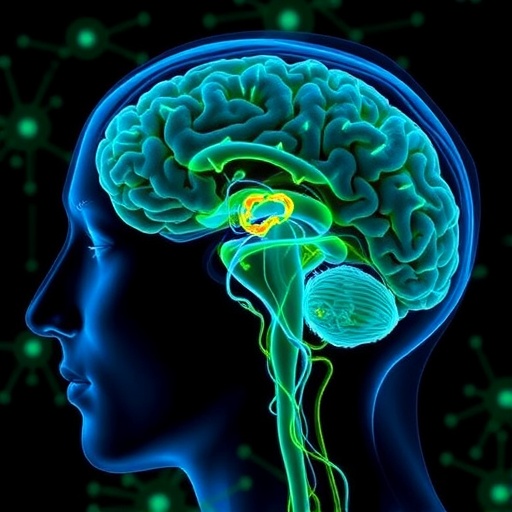A groundbreaking study has unveiled the intricate connections between N-methyl-D-aspartate receptor (NMDAR) subunits and neuronal apoptosis in the trigeminal ganglion, particularly in a model of male rats suffering from migraine. This research, conducted by Vafaeian, Vafaei, Parvizi, and their colleagues, offers profound insights into the molecular underpinnings of migraine, presenting compelling evidence on how certain interventions could alter its course. Central to this study is the use of Moringa oleifera, a plant renowned for its medicinal properties, and its potential therapeutic benefits for migraine sufferers.
Migraine is not just a simple headache; it’s a debilitating condition that affects a significant portion of the population, often leading to severe disability. Understanding its pathophysiology has become crucial for developing effective therapies. The trigeminal ganglion, a critical structure in this context, plays a pivotal role in the transmission of nociceptive signals associated with headache. By focusing on this area, the researchers aimed to dissect the molecular events that occur during a migraine episode. Central to their findings was the exploration of the role NMDAR subunits play in neuronal cell death.
NMDARs are glutamate receptors that have been implicated in various neural processes, including synaptic plasticity and memory formation. However, their role in neuronal apoptosis within the trigeminal ganglion during migraine attacks has been underexplored. This study’s detailed examination of NMDAR subunit expression presents a novel perspective on how these receptors could be influencing neuronal health and death cycles in migraine pathology. The interplay between NMDAR activity and neuronal survival is a key focus, shedding light on the molecular mechanisms that may be targeted for therapeutic intervention.
Moringa oleifera, the plant used in this study, has been traditionally recognized for its multitude of health benefits. Its rich array of phytochemicals, including flavonoids and phenolics, could play a significant role in modulating inflammation and oxidative stress—two critical components often exacerbating migraine symptoms. The research team meticulously administered an alcoholic extract of Moringa to the migraine model, evaluating its effects on both NMDAR subunit expression and neuronal apoptosis. Their findings could revolutionize how we approach migraine treatment, offering a natural alternative to conventional medications.
The methodology employed in this research was rigorous and multifaceted. The researchers utilized male rats that were subjected to migraine-inducing protocols, allowing for the study of biological changes in a controlled environment. Following the administration of the Moringa extract, the team performed a series of molecular assays to measure changes in NMDAR expression levels and indicators of neuronal apoptosis. The results demonstrated a significant modulation in the expression of NMDAR subunits, coupled with a marked reduction in apoptotic markers within the trigeminal ganglion.
The implications of these findings cannot be overstated. With migraine being a disorder often resistant to treatment, discovering a natural compound like Moringa oleifera that can potentially influence its underlying mechanisms offers a beacon of hope for those affected. By targeting NMDAR subunits and neuronal death pathways, this approach could pave the way for novel therapeutics that not only alleviate migraine attacks but also address the chronicity associated with the condition.
Additionally, the study opens new avenues for research into the molecular biology of migraine disorders. Exploration of other natural compounds with similar properties as Moringa could lead to a wealth of knowledge that might provide alternative therapeutic strategies. The understanding of how dietary and herbal supplements can impact neurological health could revolutionize the landscape of migraine management, moving towards a more integrative model of care.
Thus far, the findings have garnered significant attention within the neuroscientific community, spurring discussions on the potential for integrating botanical therapeutics into clinical practice. As the study highlights the need for more extensive trials, it also underscores the importance of understanding the molecular mechanisms at play in such complex conditions as migraine. The intersections of neuroscience, pharmacognosy, and clinical practice seem more relevant now than ever, urging researchers to collaborate across disciplines.
In conclusion, Vafaeian and the team have blazed a trail in migraine research with their innovative approach. Their work not only contributes to our understanding of the molecular biology of migraines but also highlights the potential of utilizing natural products in medical science. With further research and exploration, we may soon witness a shift in how migraine is treated, embracing a holistic view that combines pharmacological and natural treatments. This study serves as a significant stepping stone towards that future, reflecting a growing interest in understanding the interplay between natural compounds and human health.
As healthcare professionals and researchers alike analyze these findings, the promise of innovative treatments for migraine seems brighter than ever. The integration of advanced molecular assessments with traditional medicine could herald a new age in the management of neurological disorders, providing hope not only for millions who suffer from migraines but also for the broader landscape of neurology.
With the dawn of new scientific inquiries on the horizon, the anticipation builds around what further investigations will yield in this dynamic field of study. Comprehensive approaches that consider both molecular biology and herbal medicine may shape the future of migraine treatment, fully harnessing the rich potential that nature offers to modern medicine.
Safe to say, the era of holistic approaches backed by rigorous science is upon us, making it an exciting time for both researchers and practitioners. All eyes will be on the developments that unfold next, as the ongoing pursuit of knowledge continues to illuminate the path to novel and effective migraine therapies.
Subject of Research: Migraine Pathophysiology and Treatment using Moringa oleifera
Article Title: Molecular assessment of NMDAR subunits and neuronal apoptosis in the trigeminal ganglion in a model of male migraine-induced rats following Moringa oleifera alcoholic extract administration.
Article References:
Vafaeian, A., Vafaei, A., Parvizi, M.R. et al. Molecular assessment of NMDAR subunits and neuronal apoptosis in the trigeminal ganglion in a model of male migraine-induced rats following Moringa oleifera alcoholic extract administration.
BMC Neurosci 26, 9 (2025). https://doi.org/10.1186/s12868-025-00928-w
Image Credits: AI Generated
DOI: 10.1186/s12868-025-00928-w
Keywords: Migraine, NMDAR, Moringa oleifera, neuronal apoptosis, trigeminal ganglion, natural remedies, botanical therapeutics, molecular biology.




